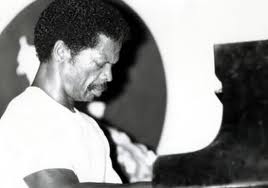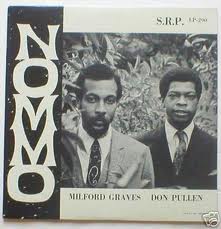December 26 is a birthday I share with some great musicians — John Scofield and the late Quinn Wilson, for two. But yesterday I was thinking of a Christmas baby: pianist Don Pullen,  12/25/45- 4/22/95. A Don Pullen Arts Exhibit opens today in Roanoke, VA, his home town, produced by the Jefferson Center and Harrison Museum of African American Art, and that’s a fine tribute. But I hate to think that Pullen’s music may be falling out of consciousness or access.
12/25/45- 4/22/95. A Don Pullen Arts Exhibit opens today in Roanoke, VA, his home town, produced by the Jefferson Center and Harrison Museum of African American Art, and that’s a fine tribute. But I hate to think that Pullen’s music may be falling out of consciousness or access.
His very first records with drummer Milford Graves are extremely rare (self-produced, from a concert at Yale, as Nommo), and so is some of the brilliant playing he did with others, like A Well Kept Secret by drummer Beaver Harris’ 360 Degree Experience, with bari saxist Hamiett Bluett.  Pullen’s most prominent position in someone else’s ensemble was his stint with Charles Mingus resulting in the albums Changes One and Changes Two, leading after Mingus’ death to a quartet with saxophonist George Adams, bassist Cameron Brown and drummer Dannie Richmond. I think Pullen’s finest album may be The Sixth Sense, for which I wrote liner notes. After writing a Down Beat feature about Pullen, I was invited to the residency at the Yellow Springs Institute where he organized his breakthrough African Brazillian Connection, and I annotated a couple of more albums, including Sacred Common Ground, on which he forged a bridge between jazz and Native American drumming/chanting by the Chief Cliff Singers. In ’97 I wrote notes to The Best of Don Pullen: The Blue Note Years, which perhaps can serve as an introduction, a valedictory, a spur to remembering. The man had music in his soul.
Pullen’s most prominent position in someone else’s ensemble was his stint with Charles Mingus resulting in the albums Changes One and Changes Two, leading after Mingus’ death to a quartet with saxophonist George Adams, bassist Cameron Brown and drummer Dannie Richmond. I think Pullen’s finest album may be The Sixth Sense, for which I wrote liner notes. After writing a Down Beat feature about Pullen, I was invited to the residency at the Yellow Springs Institute where he organized his breakthrough African Brazillian Connection, and I annotated a couple of more albums, including Sacred Common Ground, on which he forged a bridge between jazz and Native American drumming/chanting by the Chief Cliff Singers. In ’97 I wrote notes to The Best of Don Pullen: The Blue Note Years, which perhaps can serve as an introduction, a valedictory, a spur to remembering. The man had music in his soul.
At his best—and at the piano, he was always at his best — Don Pullen was peerless. The proof endures in these grooves: nine original pieces which Pullen, with dedicated compatriots, realized during the last phase of his career, a seven-year association with Blue Note Records. Exhibiting his consistently virtuosic level of subtlety, elegance and sheer excellence, this compilation album is an admirable introduction, rather than a summation, of a person’s musical expression that’s rich with light, insight and grace for whomsoever is lucky enough to listen.
It is music of a multitude of dimensions, as Don was an inspired keyboard artist, an unforgetttable improviser, a composer of many tuneful and moving themes, a daring band leader and an impeccable accompanist. It’s music which — from its moment of creation, evermore — bears its makers’ intensity, ultimately joyous spirit, and hard-won wisdom regarding life. Pullen’s playful lines, his fully voiced chords and his unique keyboard glisses contain and releasefeelings through vivid narrative, insightful portraiture and probing reminiscence. Pullen’s pieces seem to allow him to sing arias, drum thunder, joust, feast and love across an ocean of octaves, to reach from his childhood in Roanoke, Virginia to far beyond his death in New York in 1995.
Hear: Powerful rhythms pulse up from the ground beneath Pullen’s feet through his wiry, upright and eventually swaying torso (he might be wearing ankle bells, a hiply cut future-suit, or a torreador’s brocaded black jacket and tailored slacks), down his muscled forearms, into his strong wrists, cigar-thick fingers, calloused tips, palms and hand-heels. Those rhythms summon and are shaped by impulses from Pullen’s heart and soul, providing the power of the bright-skipping, soon sweeping clusters he rains upon the keys. Never more than a few beats into a chorus, musical ideas start to stream from Pullen, flowing towards us with solace and cheer. Here’s music to bask in, to absorb and recall.
By 1979, when Don Pullen came to record his Blue Note debut (Breakthrough, by the Don Pullen-George Adams Quartet, a collective drummer Dannie Richmond liked to brag that he led, and bassist Cameron Brown supported as a stalwart oak), he was a mature jazzman, age 36, accomplished if not completely fulfilled. Son of a Southern family, with a background in gospel church music, semi-classical parlor recitals and soul music studio sessions and encouragement from Muhal Richard Abrams, co-founder of Chicago’s Association for the Advancement of Creative Musicians, Pullen had made his mark as a member of the mid ’60s New York City underground. He’d debuted on ESP Disks with multi-instrumentalist Guiseppi Logan, and independently issued ferocious, exhaustive duets with drummer Milford Graves taped live-in-concert at Yale University. In 1971, Pullen left his steady gig with Nina Simone to join Art Blakey’s Jazz Messengers briefly and land in the final great ensemble led by bassist Charles Mingus. A Mingus band member until ’75, he appears on Changes One and Changes Two.
All the while Don took gigs under his own name: appearing unadvertised, often on organ, in black clubs of New York’s Harlem and nearby New Jersey, recording solo for a Canada’s Sackville label and Japanese Trio, some spotty combo albums for Atlantic and several adventurous productions for Italy’s Black Saint-Soul Note combine. In the process he’d become a pre-eminent figure in avant gut-bucket and new world/jazz/blues circles, collaborating with Hamiet Bluiett, David Murray, Beaver Harris, John Scofield, Olu Dara, the Art Ensemble of Chicago (Fundamental Destiny) and Kip Hanrahan, among many others.
Tenor saxophonist George Adams, who Pullen had brought to Mingus, painted in similarly vibrant hues (evident in both burning and ballad idioms), and after Mingus’s demise the Pullen-Adams (Richmond/Brown) Quartet cut 10 albums over 10 years, their final two for Blue Note. When Dannie Richmond died and Adams fell ill, Pullen set out to establish his trio with New Beginnings (here represented by its title track and “Jana’s Delight,” probably Pullen’s finest romp). A happy studio meeting with bassist Gary Peacock and drummer Tony Williams, New Beginnings raised Pullen’s visibility and furthered his songwriting rep. Random Thoughts, its follow up with his working-band bassist Jame Genus and drummer Lewis Nash, also comprised all original melodies (including “Andre’s Ups and Downs” for his son, and “Indio Gitano”) that depicted people and places near and dear to Don.
In 1990, through a grant administered by the Yellow Spring Institute of Art in Chester Springs, PA, Pullen was afforded a unique opportunity to further his global musical explorations.
“I’ve always had an affinity for Latin music and African music,” he explained at the end of a two-week residency during which he’d convened the African Brazilian Connection, a band which embraced musicians from Cameroon, Panama, Sao Paulo and Senegal. “The very first composition I ever wrote when I was a kid was a samba, or something like that. I play those tunes very easily, and they feel very good. The music of Brazil and flamenco and the music we play in America — blues and jazz and so forth — all has its roots in Africa. That’s why we can all play together.”
Following the ABC’s three albums and tour of Europe, as well as the diagnosis of his terminal disease and an initial course of treatment, Pullen pursued the musical threads that link all peoples to Sacred Common Ground, a historic collaboration with the Chief Cliff Singers, Native Americans from the Salish-Kootenai Reservation in Montana. “Reservation Blues,” co-writtten by Pullen and the Singers’ leader Mike Kenmille, turns on what I remember from the session itself as not an edit but a perfect fermata. At the end of the Indians’ chanting there’s a pregnant pause . . then, picking up the same earth beat, Don rolls out a long blue road under the moans and protests of alto saxophonist Carlos Ward and trombonist Joe Bowie, atop the pocket of bassist Santi Debriano and drummer J.T. Lewis, accented by percussionist Mor Thiam.
Pullen’s playing there, and the grandeur of his ABC’s track “El Matador,” suggests something of his resistence of the mediocre and the debilitating, his ferocious will to create a beautiful, enduring mark. Perhaps no piece from Pullen’s oeuvre so aptly shows his sublime touch, delicacy and sense of emotional nuance as his unaccompanied rendition of “Ode To Life,” which ends this collection. Originally written and dedicated to George Adams, this rendition was its composer’s meditation on his own mortality, and proceeds through a range of moods to come to rest in serenity.
The Best of Don Pullen: The Blue Notes Years represents a heartfelt selection of the man’s music by some of the people who were closest to him, notably his companion Jana Haimisohn, his agent Eric Hanson, his children André (his eldest), Don Jr., Tracy and Keith and his Blue Note producer Michael Cuscuna. It’s just a fraction of Pullen’s best, though, about an eighth of his Blue Note output — substantial, yet just a step in taking his full measure.
What retrospective, however complete, can ever take an artist’s full measure? Here’s my standard: I still very much enjoy listening to Don Pullen.

